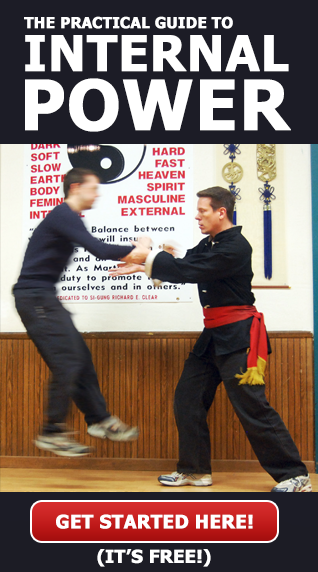Tai Chi Chuan, Bagua & Hsing-I Comparison & Contrast (part 3)
Ba Gua practitioners are known for walking, traveling and moving in circles that range from very tight and close circles to circles of about 30 feet in diameter and walking the circle is one the signature practices of Bagua. In as much as Hsing-I is very confrontational Bagua is very evasionary. In a legendary fight between Dong Hai Chuan and a Hsing-I master Kuo Yun Shen supposedly the fight went on for 3 days before Dong Hai Chuan finally landed a hit on Kuo Yun Shen. (Certainly if the 3 days part of the story is true then it was more likely a friendly sparring and comparing of methods and techniques than a fighting match). After the “match” the two became great friends and were said to train with / from each other becoming reasonably proficient in each others arts. If you have read the previous post on Hsing-I then you may have had questions about how someone could even fight such an art let alone beat it. The basic answer is simple “Move” and “Evade”. The best way to beat a straight line is to evade by moving in a circle around it. This is the forte of Bagua.
The actual name of the art is Ba Gua Chang which translates as 8 Diagram(shape) Palm. As an art Bagua is a mixture of hard and soft often using force but sometimes using softness. Circles of all shapes and sizes from small non stepping turning and pivoting to rapidly stepping around a large area such as a 30 foot circle are trained. Many different kinds of stepping are trained and internal energy principles are trained as well. In Bagua there are many different internal training methods including specific types of energy palms such as iron palm, vibrating palm, poison hand, penetrating palm, crushing palm and others.
Evasion and flanking movement skills are the primary movement of Ba Gua. Ba Gua will flank and then immediately land a devastating hand strike that is meant to end the fight while still moving so that if the recipient actually survives the strike and continues to attack they will still find the Ba Gua practitioner difficult to hit or even touch as the circle walking and flanking is persistently continual until the situation is concluded. The art is quite diverse and there are many different styles, moves and patterns to be found in the art of Bagua. The most common moves / techniques are various kinds of circle walking and with an emphasis on training many various and rapid ways to change direction. Single Palm Change is the most common move found in all of the Bagua systems even though most of the various styles of bagua have their own version of the move that is slightly different from everyone else’s.
Of the 3 major internal arts Bagua has the most obvious complicated physical hand and movement patterns. This is not to say that it is better than the other two arts. Fortunately, efficiency does not have to be complicated on the surface in order to work very well in practice. So, do not rule out or underestimate the simple appearance of the Hsing-I or flowing movements of the Tai Chi Chuan just because they do not physically appear as sophisticated as bagua. There is much more going on in the internal arts than meets the eye.
Ba Gua is a barbed wire ball refers to the idea that a good bagua practitioner wraps you up and you feel like you have just tangled with a ball of barbed wire in that you can not hit it but it is all over you and even if you grab it somewhere you are still getting the worst of it. The center of the ball and where and how the ball is striking you can easily change at any time such that you can only find softness that you can not hit with any effect and every time you are hit it is with hardness that you can not stop.

Enjoyed these articles…always learn some thing from your post. Thanks.
Question: What would be the best way to study Bagua through a DVD distance learning system. Could it be done?
Thanks…
Hey Dan,
The best way to learn Bagua long distance is through our Clear’s Silat program. Bagua is taught in Phase 5 and it uses all the information & principles from phases 1-4 so that when you learn the Bagua you can apply it very quickly instead of spending years studying Bagua without being able to truly apply it.
Over half of the material in phase 1 applies directly to Bagua. Below is a few of the phase 1 DVDs that will be of particular interest to someone who is studying or interested in Bagua.
Phase 1 Vol 1 – The Open Hand
Phase 1 Vol 3 – Constant Motion, Ranges & Decoy
Phase 1 Vol 4 – Zero Pressure
Phase 1 Vol 7 – Action Beats Reaction (coming soon)
Phase 1 Vol 8 – Upper Body Art: Hand & Elbow Destructions
Phase 1 Vol 9 – Lower Body Art: Knee & Foot Destructions
Phase 1 Vol 11 – Touch Reference
out of this world